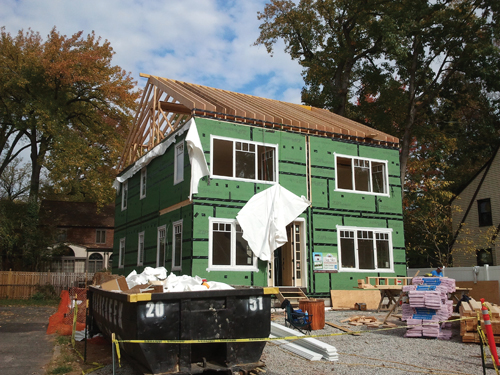.jpg)
Imagine moving into a house, never paying a dime on heating or air and yet never being bothered by the change in temperature as seasons pass by.
A new house on Wyndham Road in Teaneck, one of the first Passive Houses in the state, will allow its residents to live such a life.
The home, designed by Teaneck architect Malka van Bemmelen, AIA, and owned by Lenny Moskowitz and Deborah Teplow, is incredibly well insulated. All of the heating comes from passive solar gain, body heat and output from electrical devices in the home and, as needed, from two mini split units that provide minimal heating and cooling. Shading and window placement minimize air conditioning costs in the summer. The design slashes up to 90 percent of space heating costs.
“It’s part of being gentle to the earth and taking advantage of as many resources as we can as gently as we can,” Teplow said.
In fact, with solar panels mounted on the roof providing electricity and a rain-water collecting cistern connected to the toilets, the house will actually produce more energy than it uses. Teplow grew up in California and, as someone who has experienced droughts, is very sensitive to the need to conserve water. Moskowitz is anticipating that the six percent extra cost for the passive design and construction will be recouped within seven years.
The walls are four inches thicker than normal building walls and have an additional two inches of insulation on the exterior. The term Passive House refers to a low energy construction standard developed in Germany over 20 years ago, which uses software to dramatically reduce the requirement for space heating and cooling, while creating excellent indoor comfort levels. Around twenty variables, like the number of appliances the home owners use, with tons of possible permutations are worked into the software to make sure the house is designed just right.
The 2,300-square-foot house constructed of four modules is not yet certified; to be certified, it needs to meet certain air tightness requirements when blower-door tested at completion. The air tight design means the house may have more moisture, but the design also incorporates a heat recovery ventilator that will continuously ventilate the house, bringing in fresh air and taking out stale air.
Moskowtiz estimated that the construction bill will total between $375 and $385 thousand. Homes can be certified Passive House after being retrofitted though it is much easier to achieve high levels of energy efficiency by building new. There are three main ways to retrofit: building on the outside of the home to make the walls thicker, making the walls thicker from the inside thereby shrinking the room, or packing in extra dense insulation into the walls.
“Nowadays, with all the various materials available (insulations), assorted products (like the triple glass windows) and the software from Passive House, it just makes sense to build this way,” van Bemmelen said. “And whatever energy bills they will have from the mini splits and general electricity, it should be more than covered by the solar panels on their roof, making this in effect a net-zero home.”
This house’s story started in 2010 when Teplow and van Bemmelen ran into each other at Chef Central and started talking about super energy efficient homes. At that time, there were only thirteen certified Passive Houses in the entire country. At first, they were going to design a house to Energy Star Climate Choice specifications, which was the most rigorous energy standard out there. But when Moskowtiz discovered the Passive House methodology online, they changed plans.
“We were looking for a simple, elegant solution to the energy problem and this one, at its core, seemed the best,” Teplow said, adding that the 27 regions in Europe which require this as a building standard are proof of concept.
In 2011 van Bemmelen enrolled in a Passive House course at Parson’s; she became a certified consultant a few months later during the annual testing. Her design, and all Passive House designs, require higher R values, a measure of insulation, along with tighter construction.
Bergen County is zone 5A on climate maps and, typically, houses in this zone need R-38 roofs, R-20 walls and R-10 foundation walls. The energy efficient design for this house has an R-67.5 roof, R-40.85 walls and R-36.2 foundation walls, in addition to 8” of foam under the basement slab, providing R-30.4, a location which typically has no insulation at all.
More intense insulation does work. The old Moskowitz-Teplow’s home had thickly insulated walls and because of that the heat of the computer and printer inside Teplow’s home office raised the room temperature five degrees in the winter.
The couple should be able to move in to their new home, which Moskowitz believes meets the U.S. Green Building Council’s Platinum LEED status, at the end of December or beginning of January.
“We have a responsibility that we live not only together with people, but also together with our natural resources.” Teplow said. “What we do has an impact. Even if it’s a small impact, we each of us play a role.”
By Aliza Chasan










